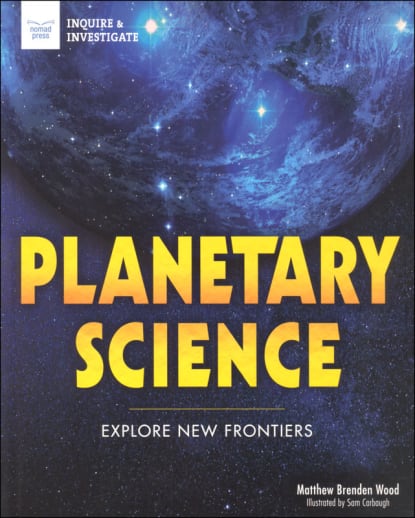This fun astronomy book for teens combines informative text with colorful diagrams, comic inserts, and hands-on projects to provide a foundational understanding of our Solar System. Enjoy an in-depth look at the hot and cold planets, gas giants, ice giants, and dwarf planets, as well as asteroids, comets, and more! Explore fascinating facts– how planets form, why they travel on their orbits, and how space technologies help us learn more. Home-friendly activities such as creating a scale model of planets or crafting a comet in the kitchen help to bring concepts to life. Each chapter ends with key questions, a “Space Element” feature for deeper thinking, vocabulary, and a related activity. QR codes throughout the book link the reader to additional primary source information, websites, and videos. A map of the Solar System with statistics is featured at the front of the book, while back pages include a glossary of terms and recommended resources for further learning. ~Nancie
Planetary Science: Explore New Frontiers (Inquire and Investigate)
SKU
009294
ISBN
9781619305717
Grade 7-10
These icons are designed to help you quickly understand and learn important information about our products.
Teaching Method
Traditional
Teacher-centered curriculum commonly used in classrooms that may include a text, teacher manual, tests, etc.
Charlotte Mason
A methodology based on the work of a 19th century educator who maintained that children learn best from literature (Living Books), not textbooks.
Classical
A methodology based on the Latin Trivium (three stages of learning), including the grammar stage (memorization and facts), logic stage (critical thinking), and rhetoric stage (developing/defending ideas).
Unit Study
A thematic or topical approach centered around one topic that integrates multiple subject areas.
Montessori (Discovery)
A methodology based on the work of a 20th century educator that emphasizes student and sensory-driven discovery learning and real-life applications.
Other
Other methodologies
Religious Content
Secular
Contains content contrary to common Christian beliefs (i.e. evolution).
Neutral
Avoids religious or theoretical topics or presents multiple viewpoints without preference.
Christian/Religious
Faith-based or including instructional religious content.
Learning Modality
Auditory
Learns through listening, talking out loud or reading out loud.
Visual
Learns through seeing, prefers written instructions and visual materials.
Kinesthetic/Tactile (Hands-On)
Learns through moving, doing and touching.
Multi-Sensory
Curriculum that employ a variety of activities/components.
Presentation
Sequential
Curriculum progresses through well-defined learning objectives. Emphasizes mastery before moving to the next topic.
Spiral
Topics and concepts are repeated from level to level, adding more depth at each pass and connecting with review.
Conceptual/Topical
Focus is on the “why,” often with a unifying concept as well as specific skills; coverage may be broader.
Teacher Involvement
Low Teacher Involvement
Student-led materials; parent acts as a facilitator.
Medium Teacher Involvement
A mix of teacher-led time and independent student work.
High Teacher Involvement
Teacher-led lessons; may utilize discussions, hands-on activities and working together.
Additional Materials Required
No other materials needed
Everything you need is included.
Other Materials Required
There are additional required resources that are a separate purchase.
Other Materials Optional
There are additional resources mentioned or recommended but are not absolutely necessary.
Consumable
Consumable
Designed to be written in; not reusable.
Non-Consumable
Not designed to be written in; reusable.
Our Price
$17.95 $17.95 $13.50
Rainbow Savings: $4.45
Description
Publisher's Description of Planetary Science: Explore New Frontiers (Inquire and Investigate)
In Planetary Science: Explore New Frontiers, readers ages 12 to 15 embark on a journey through the solar system and beyond, exploring planets, moons, dwarf planets, exoplanets and everything in-between. For many ancient cultures, planets were mysterious objects that moved against the backdrop of the heavens in strange but predictable patterns. Ever since Galileo Galilee first used a telescope to explore the moons of Jupiter, we’ve known that the planets are much more than mysterious points of light in the night sky. With the creation of incredible technologies such as space probes, giant ground-based telescopes, and Earth-orbiting observatories, we’ve learned that Mars once had water on its surface, that Jupiter’s Great Red Spot has been churning for centuries, and that thousands of exoplanets circle distant suns. Planetary science is also exciting because of what we don’t know. Was there ever life on Mars? Is Planet Nine lurking in the outer reaches of the solar system? Will we ever find another Earth? How far can we go? In Planetary Science, readers examine the latest information on Pluto, the discoveries of the Mars rover Curiosity, and the incredible catalog of distant planets uncovered by the Kepler Space Telescope. They learn about how planets are formed and why they travel on their orbits. Planets, those pinpricks of light you might spot on a clear night, come closer through informative illustrations, links to online primary sources, illuminating sidebars and fun facts, and hands-on, in-depth activities, such as building scale models of planets, hunting for alien worlds through citizen science, and crafting a comet in the kitchen. Planetary Science also promotes critical thinking skills through inquiry, discovery, and research by encouraging readers to explore questions that remain unanswered, such as whether Mars once had life or the possibility of a ninth planet hiding in the furthest reaches of the solar system. With discoveries being made almost every day, it’s an exciting time to be a planetary scientist!
Details
| Product Format: | Paperback |
|---|---|
| Grades: | 7-10 |
| Brand: | Nomad Press |
| ISBN: | 9781619305717 |
| Length in Inches: | 10 |
| Width in Inches: | 8 |
| Height in Inches: | 0.3125 |
| Weight in Pounds: | 0.7 |
Videos
Reviews

